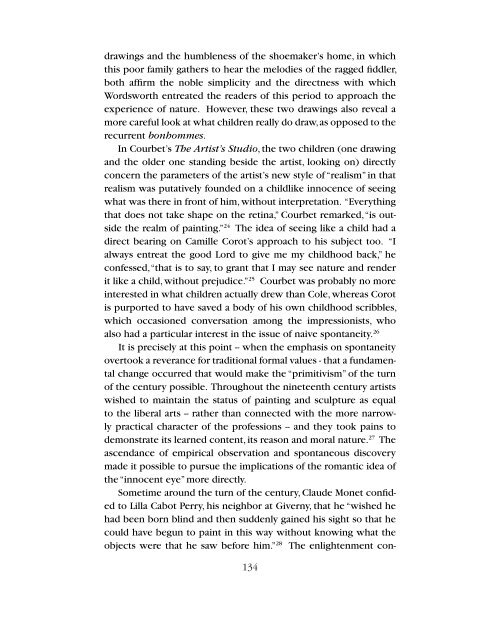Jonathan Fineberg – The Postman Did It – Children’s Art and the Avant-garde
Excerpt from “A Kid Could Do That!”, an extensive publication prepared by Galerie Gmurzynska on the occasion of the large-scale eponymous exhibition project at Art Basel Miami Beach 2014, conceived with Hollywood luminaries Baz Luhrmann and Catherine Martin.
Excerpt from “A Kid Could Do That!”, an extensive publication prepared by Galerie Gmurzynska on the occasion of the large-scale eponymous exhibition project at Art Basel Miami Beach 2014, conceived with Hollywood luminaries Baz Luhrmann and Catherine Martin.
- No tags were found...
Create successful ePaper yourself
Turn your PDF publications into a flip-book with our unique Google optimized e-Paper software.
drawings <strong>and</strong> <strong>the</strong> humbleness of <strong>the</strong> shoemaker’s home, in which<br />
this poor family ga<strong>the</strong>rs to hear <strong>the</strong> melodies of <strong>the</strong> ragged fiddler,<br />
both affirm <strong>the</strong> noble simplicity <strong>and</strong> <strong>the</strong> directness with which<br />
Wordsworth entreated <strong>the</strong> readers of this period to approach <strong>the</strong><br />
experience of nature. However, <strong>the</strong>se two drawings also reveal a<br />
more careful look at what children really do draw, as opposed to <strong>the</strong><br />
recurrent bonhommes.<br />
In Courbet’s The <strong>Art</strong>ist’s Studio, <strong>the</strong> two children (one drawing<br />
<strong>and</strong> <strong>the</strong> older one st<strong>and</strong>ing beside <strong>the</strong> artist, looking on) directly<br />
concern <strong>the</strong> parameters of <strong>the</strong> artist’s new style of “realism” in that<br />
realism was putatively founded on a childlike innocence of seeing<br />
what was <strong>the</strong>re in front of him, without interpretation. “Everything<br />
that does not take shape on <strong>the</strong> retina,” Courbet remarked, “is outside<br />
<strong>the</strong> realm of painting.” 24 The idea of seeing like a child had a<br />
direct bearing on Camille Corot’s approach to his subject too. “I<br />
always entreat <strong>the</strong> good Lord to give me my childhood back,” he<br />
confessed, “that is to say, to grant that I may see nature <strong>and</strong> render<br />
it like a child, without prejudice.” 25 Courbet was probably no more<br />
interested in what children actually drew than Cole, whereas Corot<br />
is purported to have saved a body of his own childhood scribbles,<br />
which occasioned conversation among <strong>the</strong> impressionists, who<br />
also had a particular interest in <strong>the</strong> issue of naive spontaneity. 26<br />
<strong>It</strong> is precisely at this point -- when <strong>the</strong> emphasis on spontaneity<br />
overtook a reverance for traditional formal values - that a fundamental<br />
change occurred that would make <strong>the</strong> “primitivism” of <strong>the</strong> turn<br />
of <strong>the</strong> century possible. Throughout <strong>the</strong> nineteenth century artists<br />
wished to maintain <strong>the</strong> status of painting <strong>and</strong> sculpture as equal<br />
to <strong>the</strong> liberal arts -- ra<strong>the</strong>r than connected with <strong>the</strong> more narrowly<br />
practical character of <strong>the</strong> professions -- <strong>and</strong> <strong>the</strong>y took pains to<br />
demonstrate its learned content, its reason <strong>and</strong> moral nature. 27 The<br />
ascendance of empirical observation <strong>and</strong> spontaneous discovery<br />
made it possible to pursue <strong>the</strong> implications of <strong>the</strong> romantic idea of<br />
<strong>the</strong> “innocent eye” more directly.<br />
Sometime around <strong>the</strong> turn of <strong>the</strong> century, Claude Monet confided<br />
to Lilla Cabot Perry, his neighbor at Giverny, that he “wished he<br />
had been born blind <strong>and</strong> <strong>the</strong>n suddenly gained his sight so that he<br />
could have begun to paint in this way without knowing what <strong>the</strong><br />
objects were that he saw before him.” 28 The enlightenment con-<br />
134

















